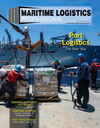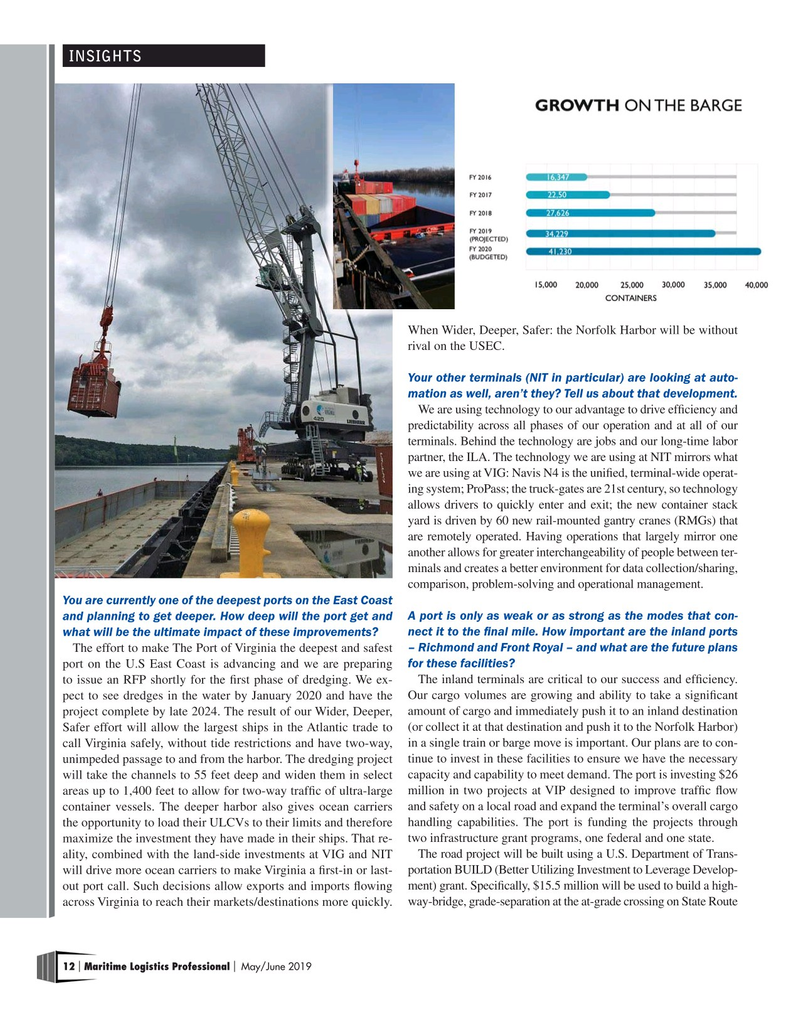
Page 12: of Maritime Logistics Professional Magazine (May/Jun 2019)
US and International Navy Ports
Read this page in Pdf, Flash or Html5 edition of May/Jun 2019 Maritime Logistics Professional Magazine
INSIGHTS
When Wider, Deeper, Safer: the Norfolk Harbor will be without rival on the USEC.
Your other terminals (NIT in particular) are looking at auto- mation as well, aren’t they? Tell us about that development.
We are using technology to our advantage to drive ef?ciency and predictability across all phases of our operation and at all of our terminals. Behind the technology are jobs and our long-time labor partner, the ILA. The technology we are using at NIT mirrors what we are using at VIG: Navis N4 is the uni?ed, terminal-wide operat- ing system; ProPass; the truck-gates are 21st century, so technology allows drivers to quickly enter and exit; the new container stack yard is driven by 60 new rail-mounted gantry cranes (RMGs) that are remotely operated. Having operations that largely mirror one another allows for greater interchangeability of people between ter- minals and creates a better environment for data collection/sharing, comparison, problem-solving and operational management.
You are currently one of the deepest ports on the East Coast and planning to get deeper. How deep will the port get and A port is only as weak or as strong as the modes that con- what will be the ultimate impact of these improvements? QHFWLWWRWKHÀQDOPLOH+RZLPSRUWDQWDUHWKHLQODQGSRUWV
The effort to make The Port of Virginia the deepest and safest – Richmond and Front Royal – and what are the future plans port on the U.S East Coast is advancing and we are preparing for these facilities?
to issue an RFP shortly for the ?rst phase of dredging. We ex- The inland terminals are critical to our success and ef?ciency. pect to see dredges in the water by January 2020 and have the Our cargo volumes are growing and ability to take a signi?cant project complete by late 2024. The result of our Wider, Deeper, amount of cargo and immediately push it to an inland destination
Safer effort will allow the largest ships in the Atlantic trade to (or collect it at that destination and push it to the Norfolk Harbor) call Virginia safely, without tide restrictions and have two-way, in a single train or barge move is important. Our plans are to con- unimpeded passage to and from the harbor. The dredging project tinue to invest in these facilities to ensure we have the necessary will take the channels to 55 feet deep and widen them in select capacity and capability to meet demand. The port is investing $26 areas up to 1,400 feet to allow for two-way traf?c of ultra-large million in two projects at VIP designed to improve traf?c ?ow container vessels. The deeper harbor also gives ocean carriers and safety on a local road and expand the terminal’s overall cargo the opportunity to load their ULCVs to their limits and therefore handling capabilities. The port is funding the projects through maximize the investment they have made in their ships. That re- two infrastructure grant programs, one federal and one state.
ality, combined with the land-side investments at VIG and NIT The road project will be built using a U.S. Department of Trans- will drive more ocean carriers to make Virginia a ?rst-in or last- portation BUILD (Better Utilizing Investment to Leverage Develop- out port call. Such decisions allow exports and imports ?owing ment) grant. Speci?cally, $15.5 million will be used to build a high- across Virginia to reach their markets/destinations more quickly. way-bridge, grade-separation at the at-grade crossing on State Route 12 Maritime Logistics Professional May/June 2019 | |

 11
11

 13
13
